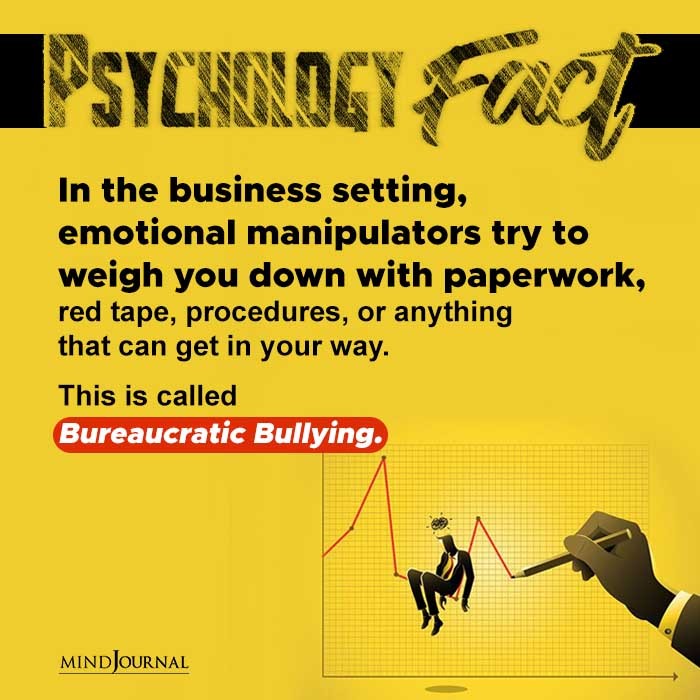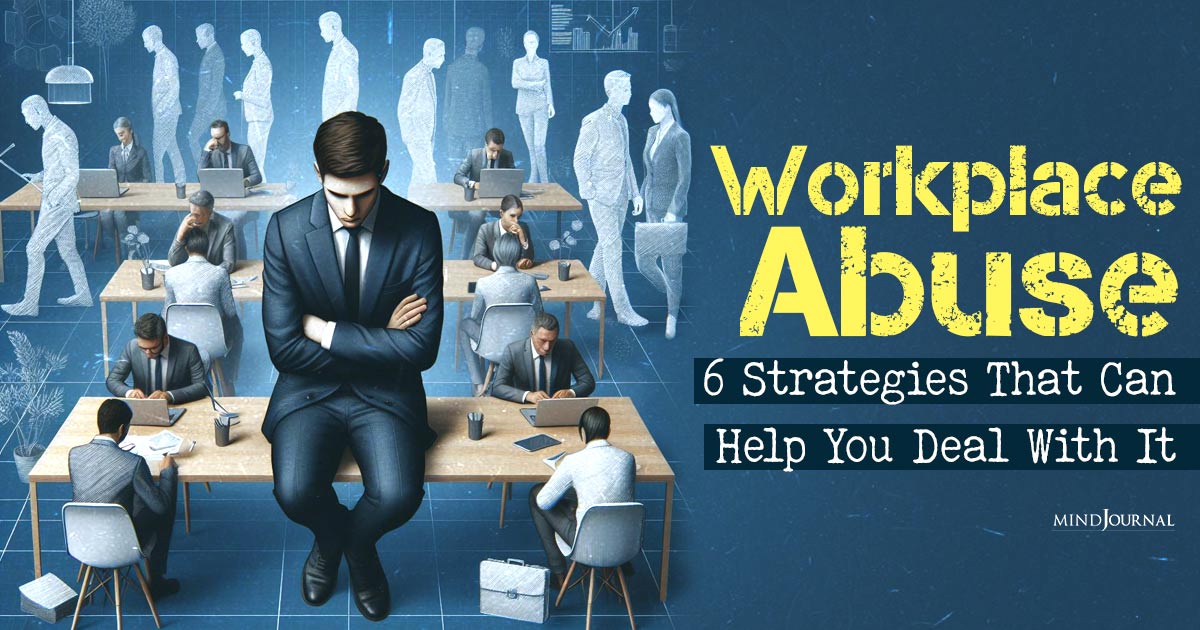Have you ever been a victim of workplace abuse? If yes, then you know how cruel it can be. Dealing with workplace bullying is one of the most difficult things to do in life, however there are some steps you can take to handle it better. Let’s explore how to deal with workplace abuse and how to deal with abusive coworkers.
KEY POINTS
- Workplace abuse causes victims to experience ambiguous loss, or a loss that remains unclear without resolution.
- Moving past a traumatic workplace requires understanding the bullying experience in order to give it shape.
- The experience of workplace trauma cannot be erased—only carried in a new way.
Workplace bullying can feel like an invisible cyclone sucking you up into the turbulent winds and dropping you down into an altered reality, dizzied and confused. Inside this new space, allies become enemies, accomplishments are redacted, and plotlines are rewritten into a story you don’t quite recognize.
Inside this revision, you experience a great loss, mourning your old life and career stability. Suddenly, your belief in a benevolent world transforms into a malevolent fairy tale.
The nonsensical nature of it all results in what therapist and researcher Pauline Boss (2012) describes as “ambiguous loss.” Boss (2021) defines ambiguous loss as “a loss that remains unclear and without official verification or immediate resolution, which may never be achieved.”
Related: The 6 Stages Of Workplace Bullying
For survivors of workplace abuse, the bullying equates to a type of death, absent the body, in which one’s daily work life—filled with positive interactions, intriguing projects, and attainable goals—is replaced with gossip, exclusion, and gaslighting.
However, unlike a physical death, workplace bullying leaves the target in a state of suspension, knowing there has been a passing but not quite sure how to define the loss.
At first, the ambiguity of it all renders the target immobile, frozen, and unable to act as questions swirl around her head, such as:
- Why are my close colleagues suddenly ignoring me?
- How can I be removed from projects I have directed for years?
- Was I purposely taken off the invite list to today’s board meeting, or is this all just a horrible misunderstanding?
The ambiguity then intensifies as colleagues shirk off direct inquiries about what is transpiring and progressively distance themselves until no strands of connections remain.
Slowly and then, with abrupt speed, the target is othered from her work community and often loses her job. Flummoxed by the injustice, with no apologies forthcoming, she attempts to untangle the knots, but instead of smoothing the strands, she is left with a jumble of snarls with no clear beginning or end.
It is often inside this moment that the deep despondency sets in—a cocktail of shame, bewilderment, and disorientation—leaving the victim of workplace bullying dangling over a mountain, with no clear future to fall into.
Now, fully immersed in ambiguous loss, targets of workplace abuse are left hanging, not knowing what or who to grab onto for support and understanding. However, there are strategies targets can use to navigate the inhumanity, helping to give shape to the nebulosity.
Below is a six-step process I use when supporting survivors of workplace abuse as they attempt to turn the page to a new chapter.

6 Effective Strategies That Will Help You Navigate Workplace Abuse
1. Know the Plotlines
Those who suffer a defined loss, like the death of a spouse, are often familiar with the grieving process. Workplace bullying, however, is often an unknown and misunderstood phenomenon, leaving victims clueless about the typical plot cycle.
However, by understanding the trajectory, targets are better able to define, ground, and normalize their own experiences inside the experiences of others.
As I have discussed in previous posts, workplace abuse cases typically unfold across six acts: target identification; jealousy and battle plans; the precipitating event; underground battles; escalating attacks and mobbing; and resignation, cover-ups, and recovery.
Related: Workplace Bullying: 6 Reasons You Are Being Bullied At Work
2. Identify the Players
Though each workplace bullying case is unique, the players are predictable. There is the Dragon who takes on the role of the bully, targeting a Creative or victim, typically for one of three reasons: productivity that shakes the status quo, a difference that challenges the hierarchy, or whistleblowing that calls out bad behaviour.
To carry out the attacks and enable the Dragon to keep her claws clean, she enlists Shapeshifters who do her bidding. There are also the Community Builders, benevolent in their intentions, but their “go along to get along” disposition prevents them from taking a stand against injustices.
Finally, there are those who direct the organization, the ones the Dragon reports to. Such positions tend to be occupied by either a Figurehead, who is vested in keeping up appearances and thus dismisses the Creative’s requests for help, or a Leader, a rare unicorn, who listens to the Creative and addresses the Dragon’s toxic behaviour head-on.
3. Construct a Timeline
Once targets of workplace abuse have familiarized themselves with the plotlines and identified the players in their own bullying experience, it is useful to construct a timeline of specific events. Though typical memories are stored chronologically as a story, making for easy and logical recall, traumatic memories are often filed as sensory images.
For this reason, when triggered, victims of workplace bullying often experience intense flashbacks, causing a full-body reaction.
By plotting traumatic events out on a traditional timeline, victims are able to ground their experiences, regaining a sense of control over what happened and allowing them to reclaim their narrative, helping to give shape to the loss (Van der Kolk, 2015).
4. Name What Was Violated
Often, it is not the bully’s actions that result in the greatest trauma for the victim but the violation of beliefs or expectations about the larger world.
When talking to survivors of workplace abuse, breaches include a sense of fair play, a commitment to the common good, loyalty to the organization’s mission, and compassionate treatment of each other.
By identifying what violations most pierced the victim’s soul, they are better able to define and hence process the loss (Denborough, 2014).
Related: Workplace Bullying: How To Deal With Bullies At Work
5. Discern What You Must Disconnect From to Turn the Page
By working through steps 1 through 4, targets of workplace bullying are able to transform a situation that once seemed ambiguous into a concrete experience defined by specific players and events.
Through this process of identification, targets are invited to decipher what specific relationships or expectations they must abandon, or sever ties with, in order to freely move forward, such as relationships with former colleagues or expectations of a specific career path.
To solidify the disconnection, the target can conduct a Ceremony of Rebirth, in which she writes or vocalizes her intent to officially conclude this chapter, opening her up to new possibilities on the other side of the loss (Martinez, 2019).

6. Conduct a Ritual
Western cultures often lack the ceremonial experiences that mark pivotal transitions. Such rituals invite participants to provide shape and celebration to ambiguous passages such as starting or ending a relationship, entering a new stage of life, or concluding a challenge.
However, research shows that engaging in rituals increases participants’ feelings of control and lessens their grief. The nature of the ritual is not as important as the labelling of it as such and then engaging in the act ceremoniously.
Examples of rituals for navigating workplace abuse include writing a letter to the bully and burning it as a symbolic representation of the severing of the relationship or planting a tree in the backyard to represent a new beginning.
The power of the ritual is not in the act itself but in labelling it as a ritual and thus embedding the act with meaning (Norton & Gino, 2014)
In closing, as Boss (1999, 2021) reminds us, closure is a myth; a fantastical bow placed upon a traumatic experience in an attempt to neaten it up and send it on its way. But the truth is, the trauma of workplace abuse is sticky, remaining part of us for the duration.
Related: Workplace Bullying: 8 Signs of A Toxic Person At Work
So the question becomes not how do we “get over” or “erase” the experience but how do we carry it in a manageable way, perhaps shifting the burden from our heart’s centre to our backpack, present but no longer directing our narrative?
Such a reframe allows us to validate what happened to us and draw upon the parts of the experience that made us more empathetic, creative, and caring—integrating all of our parts into a more holistic and evolved self.
References:
Boss, P. (1999). Ambiguous loss: Learning to live with unresolved grief. Harvard University Press. Boss, P. (2021). The myth of closure. W. W. Norton & Company. Boss, P., & Carnes, D. (2012). The myth of closure. Family Process, 51(4), 456–69. Denborough, D. (2014). Retelling the stories of our lives: Everyday narrative therapy to draw inspiration and transform experience. W.W. Norton & Company. Frankl, V. (1963). Man’s search for meaning: An introduction to logotherapy. New York, NY: Washington Square. Kübler-Ross, E. (1993). On Death and Dying. New York: Collier Books. Martinez, M. (2019). Mind body-self: How longevity is culturally learned and the cause of heath are inherited. Carlsbad, California: Hay House Inc. Norton, M. I., & Gino, F. (2014). Rituals alleviate grieving for loved ones, lovers, and lotteries. Journal of Experimental Psychology: General, 143(1), 266–272. Van der Kolk, B. A. (2015). The body keeps the score: Mind, brain and body in the transformation of trauma. Penguin Books.
Written By Dorothy Suskind Originally Appeared On Psychology Today










Leave a Reply